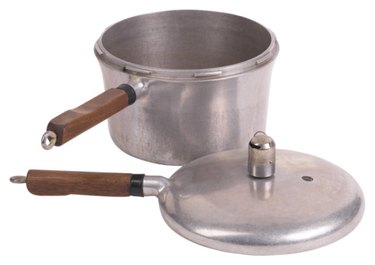
Pressure cookers today bear little resemblance to the noisy, dangerous dinosaurs our grandmothers used. Improved safety features make them safe for beginners. With a pressure cooker, you can often beat the microwave for speed -- a big plus for today's busy cooks. Even with some small drawbacks, such as not having a nonstick cooking surface, the modern pressure cooker is well worth considering.
Pro: Speed
Video of the Day
Pressure cookers are comparable to the microwave in speed of cooking. Asparagus cooks in 2 minutes in a pressure cooker after the 5 to 8 minutes it takes to build pressure. The microwave offers a similar cooking time. Beans and meats almost always cook faster in a pressure cooker. The pressure cooker easily beats stovetop and oven cooking in speed. Cleanup time is often faster because you have only used one pot.
Video of the Day
Pro: Flavor and Nutrients
Because they are sealed tightly, pressure cookers preserve moisture and juices that make more flavorful and tender meals. Because of the short cooking time and enclosed cooking, fewer nutrients get lost than with more conventional stovetop cooking.
Pro: Safety
The older versions of pressure cookers were prone to building too much steam, causing the top to blow off. Cookers available today feature newer designs with safety features built in to prevent such mishaps. They come with a vent to release pressure; if the vent becomes clogged, the pressure is released from the over-pressure plug. They also come with a manual pressure relief valve.
Con: Pressure Release
At the end of the cooking time, the recipe will specify which method to use to relieve pressure. The cold water method involves moving the heavy cooker to the sink and running cold water over it. This method is fastest if you feel comfortable with the weight of the cooker. The natural method involves simply allowing the cooker to cool. This method takes time, negating the advantage of speed. The pressure can be released through the manual release valve, but this can toughen meats.
Con: Multiple Cooking Times
If you have foods that all require about the same cooking time, the process is simple. However, if you have several ingredients with different cooking times, cooking becomes cumbersome. You must start the longest-cooking ingredient and then release pressure, add items with shorter cooking times and rebuild pressure to finish cooking.